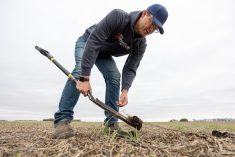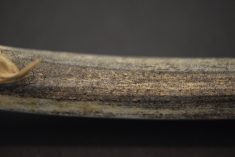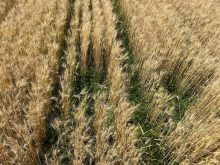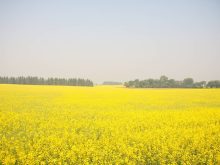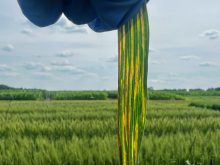Blackleg disease, caused by the pathogen Leptosphaeria maculans, is common in canola across the Prairies. It can cause very high yield loss in cultivars susceptible to the predominant blackleg races in a field.
The two best defences are:
- Crop rotation with a break of at least two years between canola crops.
- Cultivars with effective resistance to the disease pathotypes in a field.
Seed treatment and early-season fungicides can also help, especially if the first two are compromised.
This article will explain blackleg disease and how it works, then provide management details to keep canola yield loss to a minimum.
Read Also
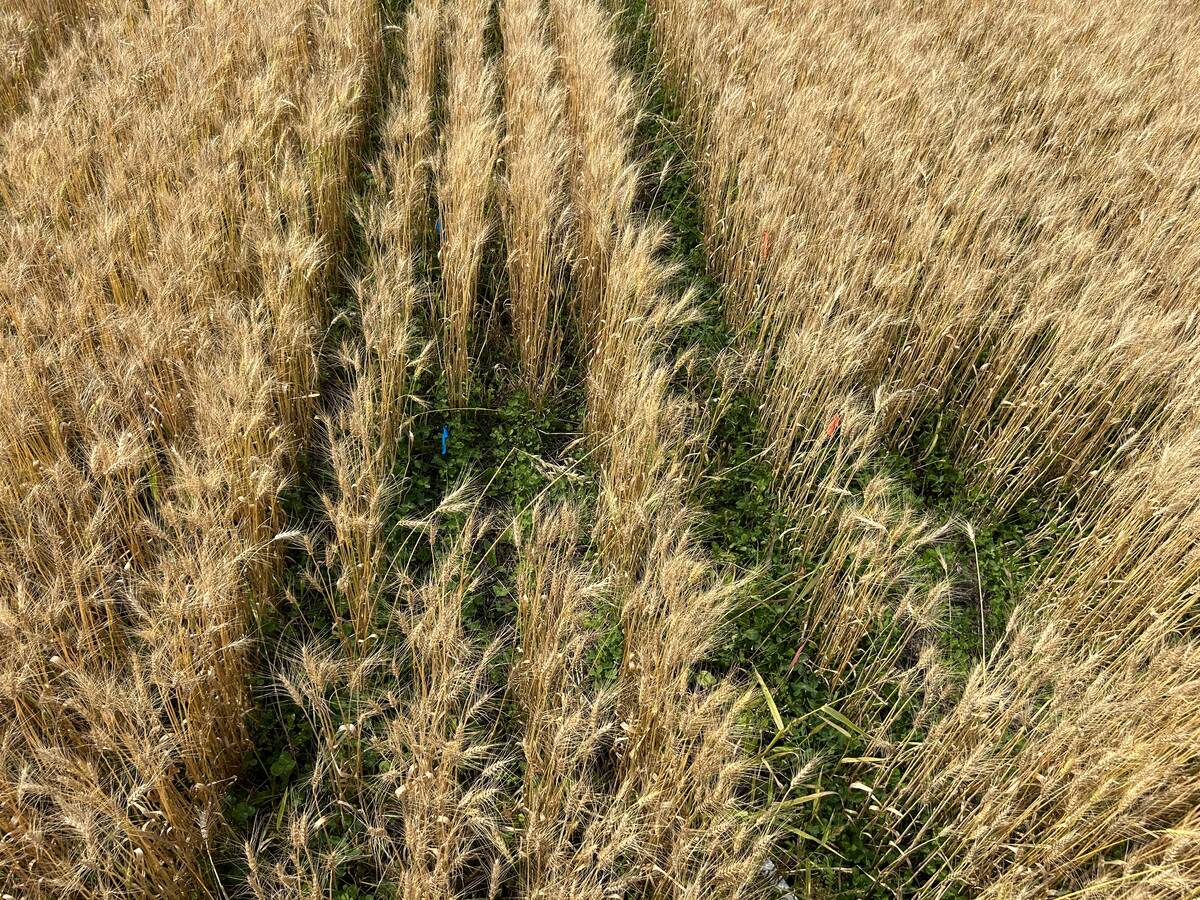
Cover crops seeded with wheat show no yield penalty in Manitoba trials
Research at Manitoba Diversification Centres shows farmers can seed legumes with spring wheat to establish cover crops without hurting yield, even in dry years.
What is blackleg?
Blackleg, also called phoma stem canker, causes necrosis of canola stems at ground level, restricting moisture and nutrient movement in the plant. In severe cases, the fungus can completely cut off this essential flow, killing the plant. In many cases, plants survive partial restriction but experience yield loss due to limited seed fill.
Two fungal pathogens cause blackleg — Leptosphaeria maculans and Leptosphaeria biglobosa. Both species are widespread throughout the Prairies. L. biglobosa is weakly virulent, and often associated with upper stem lesions. It rarely causes significant yield loss. L. maculans does more damage.
Canola plants are susceptible to blackleg infection at all growth stages. Infection at the seedling stage tends to cause more yield loss because the disease has time to develop through the growing season. That is why seed treatment and early-applied fungicide can help, especially if cultivars have limited genetic resistance. More on that later.
Blackleg pathogens overwinter on infected canola residue. In spring, fungus on old stem and root pieces produces fruiting bodies called pseudothecia and pycnidia. Pseudothecia release microscopic sexual spores, called ascospores, which become airborne and disperse to infect new canola plants. Ascospores are the primary agent of infection.
During the growing season, the pathogen also produces pycnidia, which appear as pepper-like spots within lesions on canola leaves and stems. Masses of tiny spores called pycnidiospores ooze from the pycnidia. These spores spread short distances by rain splash and wind, and cause secondary infection within a crop. Infected stubble can continue to produce ascospores and pycnidiospores for three to five years, although viability drops off considerably after two years. That is why crop rotation is an effective management practice. Again, more on that later.
From the original infection site, usually on leaves, the fungus grows down through the plant. As the season progresses, cankers form at the stem base. In severe cases, these cankers will completely fill the base of the stem, causing premature death.
The disease triangle
Diseases require a pathogen, a susceptible host and the right environment. Blackleg thrives in warm, humid conditions and with frequent rain showers.
Infection can occur in dry years, provided early-season showers produce the environment for spore germination, dispersal and infection. University of Manitoba research (Guo and Fernando, 2005) showed that pycnidiospore dispersal peaked during rainfall, and ascospore dispersal peaked several hours after rainfall of greater than two millimetres (or one-tenth of an inch). Ascospore dispersal persisted for approximately three days after such events. Wind increases pycnidiospore dispersal.
Yield loss
Agronomists can determine blackleg severity based on visual assessment of stem cross sections. With blackleg, discolouration often appears in a wedge pattern. If discolouration is more like a light-grey starburst pattern, it may be verticillium stripe.
The blackleg severity scale:
- 0 — No diseased tissue visible in the cross-section.
- 1 — Diseased tissue occupies up to 25 per cent of the cross-section.
- 2 — Diseased tissue occupies 26-50 per cent of the cross-section.
- 3 — Diseased tissue occupies 51-75 per cent of the cross-section.
- 4 — Diseased tissue occupies greater than 75 per cent of the cross-section with little or no constriction of affected tissues.
- 5 — Diseased tissue occupies 100 per cent of the cross-section with significant constriction of affected tissues; tissue dry and brittle; plant dead.
Research from Alberta (Hwang et al., 2016) found that each unit increase in disease severity reduced canola seed yield in the infected plant by 17.2 per cent. An updated yield loss model, also from Alberta researchers (Wang et al., 2020) showed the increase in yield loss as more quadratic than linear. Here is the conclusion, as written in the Wang et al. report from the Canadian Journal of Plant Science: “The results of the current study indicated that blackleg severity–yield loss relationships were explained by quadratic equations, in which slight L. maculans infection (disease severity of one) was associated with a small increase in yield relative to plants with no disease at all. When disease severity increased to ≥2, however, yields began to decrease dramatically.”
For these reasons, when disease levels approach a severity rating of two on a field (late in the season) Canola Council of Canada agronomy specialists recommend a change in blackleg management for that field in future years.
The Canola Council of Canada used these research results to build an online tool, the Blackleg Yield Loss Calculator, that calculates blackleg yield loss (and economic cost) based on field scouting results.

STEP 1: Scouting
Blackleg infection can occur at any time, and early infection tends to cause the greatest yield loss. Lesions may occur on cotyledons, leaves, stems and pods. These spots are dirty white, round to irregularly shaped, and usually dotted with numerous small, black pycnidia. Use a hand lens to help identify pycnidia specks. Under moist conditions, a viscous pink liquid carrying the pycnidiospores oozes from the pycnidia.
While very early-season scouting can indicate the need for a fungicide spray, canola growers and agronomists will use later-season scouting to assess disease severity, estimate yield loss and identify fields where increased future management is required.
Scouting at swathing or the week or two before straight combining requires cutting through the base of canola stems to assess stem canker. Look for dark necrotic discolouration in the interior of the stem base. This was described earlier, in the yield loss section.
To scout:
- Pull up 50 to 100 plants in a “W” pattern through the field, cutting 10 to 20 random stems at each of the five points in the “W.” Random selection is key to an accurate assessment. Do not seek out diseased stems. Start at a field edge, choosing the edge closest to a previous canola field.
- Clip at the base of the stem/top of the root and look for blackened tissue inside the crown of the stem. Start around one inch below ground level and take various cuts up through the stem base. The amount of infection present will help identify the level of risk and the best management practices for that field in the following years.
- Use the zero to five blackleg disease rating system to identify severity. Also, tabulate what percentage of the sampled plants have a blackleg infection. This is the “incidence” of disease.
Then, enter results in the blackleg yield loss calculator.

STEP 2: Test for blackleg races
If blackleg seems to be getting worse, agronomists and growers can test stubble to identify the dominant blackleg races present in a field. The population of blackleg races can shift in a field, and cultivars are not resistant to all races.
Canola activates a resistant response to blackleg when the plant “recognizes” the corresponding L. maculans avirulence genes (Avr) in the pathogen. This is called gene-for-gene (also called qualitative or major gene or race-specific) resistance. If a pathogen has an Avr gene that matches the plant’s resistance “R” gene, the R gene recognizes the pathogen and causes the plant to initiate a defence or immune system response. Resistance only results if both the Avr gene in the pathogen and the corresponding R gene in the host are present.
If the plant does not have an R gene that matches the pathogen’s Avr gene, the plant does not put up an immune response, and blackleg infection can occur. Stubble tests can identify the common Avr genes in blackleg-infected stubble, and growers can then choose canola cultivars with R genes that correspond with those Avr genes.
Various labs will test stem pieces for blackleg and can provide analysis of blackleg races present.
The first step is to gather samples. Collect fresh stem pieces around the time of swathing or in the weeks before straight combining. Cut just below the crown of the plant into the root material, to look for black discolouration in the cross-section. Collect 10 to 12 infected stems from each field, providing 10-inch (25-cm) stem lengths starting from around one inch below ground level. Some labs will use smaller pieces. Check with each lab for their protocols. See sidebar for labs.
Labs can also test old canola stem pieces collected from fields that will be in canola next year.
Next is the lab analysis. Labs determine the blackleg species present — L. biglobosa or L. maculans — and run DNA tests to determine the races.
Then it’s time to interpret the results. Lab results show the predominant race of blackleg or give a frequency breakdown of blackleg races found within the samples provided. Results also list the Avr genes found in each race. As noted earlier, major R genes in canola cultivars need to match up to Avr genes in the pathogen to be effective.
Lab results may look something like this:
- Race 1 — AvrLm2-Lm4-Lm5-Lm6-Lm7-Lm11 (25 per cent)
- Race 2 — AvrLm4-Lm5-Lm6-Lm7-Lm11 (50 per cent)
- Race 3 — AvrLm1-Lm4-Lm5-Lm6-Lm7 (25 per cent)
Growers will want to select a canola cultivar with a major gene that corresponds with an Avr gene found in all three races. Avirulence gene 4 (AvrLm4) is one example of a gene found in all three common blackleg races in that field. Using a cultivar deploying a major gene of Rlm4 (or Group E1) would be a suitable match. The next section describes this in more detail.
STEP 3: Choose resistant cultivars
Agronomists and canola growers can use results from step two to choose a cultivar with qualitative resistance to the predominant blackleg races in a field.
Cultivars often also have some degree of quantitative resistance (also referred to as minor gene or adult plant resistance), believed to come through the function of many genes each with a relatively small effect. Canola cultivars express quantitative resistance at the adult plant stage. The result is reduced development of necrotic tissue at the stem base compared to that found in susceptible cultivars. Canola breeders likely use both quantitative and qualitative resistance to develop blackleg-resistant canola cultivars.
Qualitative resistance, described earlier as gene-for-gene resistance, is a major-gene trait. Serious infection is more likely when the dominant blackleg race in a field does not match the cultivar’s qualitative R gene.
Using the same resistance genes repeatedly in the field over time can select for blackleg races virulent against that resistance.
The mix of blackleg races will be different in every field, and the mix changes over time. That is how a cultivar that earns an “R” rating at the time of registration may not actually perform like an R cultivar in every field.
The Western Canada Canola/Rapeseed Recommending Committee has established blackleg testing protocols and ratings to assess resistance. The resistance ratings currently available for commercial cultivars indicate disease incidence and severity relative to check cultivars in disease testing sites.
The committee uses the following to describe the level of resistance compared to the highly susceptible cultivar Westar:
- R (Resistant) = up to 30 per cent of the severity of Westar
- MR (Moderately Resistant) = 30-49 per cent of the severity of Westar
- MS (Moderately Susceptible) = 50-69 per cent of the severity of Westar
- S (Susceptible) = 70-100 per cent of the severity of Westar
Blackleg R-gene labels are voluntary for seed companies. Not all companies participate. Seed companies that participate in the blackleg R-gene labelling program use the following letter system to identify major resistance genes present in each resistance group (RG):
- RG A = Rlm1 or LepR3
- RG B = Rlm2
- RG C = Rlm3
- RG D = LepR1
- RG E1 = Rlm4
- RG E2= Rlm7
- RG F = Rlm9
- RG G = RlmS or LepR2
- RG X = unknown
Here are three example blackleg labels you could find on a bag of canola seed:
R (BC): The traditional R rating means the average field performance of blackleg resistance was below 30 per cent of Westar, the susceptible check. The additional “(BC)” designation means the cultivar contains the resistance genes Rlm2 and Rlm3.
MR (A): The traditional MR rating means the average field performance of blackleg resistance was 30-49.9 per cent of Westar check. The additional “(A)” means it contains the resistance gene LepR3 or Rlm1.
R (CX): As an R-rated cultivar, the average field performance of blackleg resistance was below 30 per cent of Westar check. (CX) means it contains the resistance gene Rlm3 and an unidentified major resistance gene.
The Canola Encyclopedia has a table of current canola cultivars and their traits. It identifies the blackleg R gene label for participating cultivars.
Genetic resistance is a key part of blackleg risk management. When growers use other management practices — especially longer breaks between canola crops and R-gene rotation — they protect genetic resistance and minimize the effect of these new strains.
STEP 4: Extend the break
Crop rotation allows for infected canola residue to decompose, reducing the spores available to infect the next canola crop.
A break of two or more years between canola crops on the same field will give most blackleg resting spores time to degrade, greatly reducing the risk. In tight rotations, scouting is essential and it becomes more important to use cultivars with genetic resistance to the most common blackleg races in a field.
Years ago Randy Kutcher, at the time a research scientist with Agriculture and Agri-Food Canada in Saskatchewan, led a rotation study to test the necessity of the recommended one-in-four rotation when growing blackleg-resistant cultivars. The four-year rotation was a key management step in the years before resistant cultivars. Kutcher published the results in the article, published in the Canadian Journal of Plant Pathology in 2013. Access it online here.
Kutcher and his co-investigators compared the following rotations:
- continuous canola (C)
- continuous pea (P)
- wheat-pea (W-P)
- wheat-canola (W-C)
- wheat-pea-canola (W-P-C)
- wheat-pea-wheat-canola (W-P-W-C)
- wheat-flax-wheat-canola (W-F-W-C)
Location one was on dark brown soil at Scott, Sask., from 1998 to 2007. Location two was on black silty clay soil at Melfort, Sask., from 1999 to 2006. Kutcher and his colleagues ran four replicates of the seven rotations with all phases of each rotation present every year. They also repeated every phase with two different canola cultivars — a blackleg-resistant hybrid typical of the most advanced cultivars available at the time, and a blackleg-susceptible open-pollinated (OP) cultivar “typical of those in use when the four-year rotation recommendation for canola was developed,” the journal article reported.
Here is an excerpt from the article abstract:
“The results suggest that canola cultivars with strong blackleg resistance can be grown more intensively than once every four years with limited yield reduction. However, the increased severity of infection and amount of infested residue produced as canola rotations are intensified, which occurs even with resistant cultivars, increases the risk of inoculum carryover, resistance breakdown and yield loss. Therefore, it would be prudent for western Canadian canola growers to adhere to less intensive inclusion of canola in rotations, such as one canola crop in four years, as an effective blackleg management strategy.”
While tighter rotations can maintain low blackleg levels, scouting is essential. Blackleg severity scores of two or more in an R-rated hybrid is a sign of race shift. On that field, canola may need a three-year break between canola crops and a shift to hybrids proven to have different blackleg R genes.
STEP 5: Use enhanced seed treatment
Gary Peng, a research scientist with Agriculture and Agri-Food Canada in Saskatoon, recently completed studies on early blackleg infection and seed treatment. Peng showed that early blackleg infection at the cotyledon stage leads to higher disease incidence and severity at canola maturity.
The Canola Research Hub has a summary of the study, called Exploring novel seed treatment options to mitigate the impact of blackleg on canola. The summary says L. maculans inoculum of over 10,000 spores per gram of soil can result in severe blackleg via root infection, especially if roots are wounded (by root maggots, for example). Of the seed treatments Peng tvested, fluopyram, Saltro (active ingredient pydiflumetofen) and Bion (acibenzolar-s-methyl) showed promise to protect susceptible cultivars against the early blackleg infection, either through roots or from cotyledon and leaf wounds. Saltro is currently available for canola in Canada. Another option, not tested in this project, is Lumiscend with the active ingredient inpyrfluxam.
Peng also co-investigated another study, along with Dilantha Fernando and Shuanglong Huang from the University of Manitoba, looking at fungicide seed treatment to protect those cotyledons. When researchers applied L. maculans ascospores and pycnidiospores directly into canola plants through fresh wounds, fluopyram seed treatment reduced blackleg relative to non-treated control. The treatment did not show a benefit on resistant cultivars. Researchers showed that seed treatment could protect canola plants from blackleg spores that enter early through wounds on cotyledons. Insect feeding and hail can cause these wounds.
Again, the critical note here is this: Is the chosen canola cultivar actually resistant to the blackleg races in a field? If resistance is compromised, seed treatment known to be effective on blackleg may be a good tool to protect against critical early-season blackleg infection.
STEP 6: Apply foliar fungicide
Early-season fungicide can benefit partially resistant or susceptible cultivars, especially if environmental conditions are moist enough to support early infection. Use Group 11 products with high water volume for coverage, and ideally apply before infection.
Gary Peng, continuing his blackleg fungicide work, also looked into foliar application on very small canola plants. In his paper, Early fungicide treatment reduces blackleg on canola but yield benefit is realized only on susceptible cultivars under high disease pressure, published in 2021 in the Canadian Journal of Plant Pathology, Peng concluded that Group 11 fungicide applied to a blackleg-susceptible cultivar at the two- to four-leaf stage could reduce disease severity enough to provide benefit. Read the paper online here.
Early-season fungicide to prevent blackleg can provide a return on investment in a field with all of the following:
- Canola is in a tight rotation.
- The canola seed lot does not have enhanced seed treatment.
- Blackleg was present in the previous canola crop and infected stubble is found in the same field or in a neighbouring field. If the field was not scouted but the area has a history of blackleg, you could assume blackleg is present. This covers the pathogen part of the disease triangle.
- The cultivar is susceptible to blackleg races in the field. Wounds from hail or insect feeding can increase the risk of infection. This covers the host part of the disease triangle.
- Moist weather with wind, mist and rain splash (early in the season, during the critical infection window) can increase the spread of blackleg spores from stubble to living tissue. Fungal growth also tends to be more active in moist conditions. This covers the environment part of the disease triangle.
Fungicides can go in a tank mix with herbicides — both of which tend to provide greater economic benefit when applied early. Fungicides for blackleg have protectant activity and little or no eradicant activity, so growers will want to apply them before blackleg symptoms appear. Consult the label or a current guide to crop protection for application details on all fungicides registered for blackleg.
Noteworthy extras
Verticillium stripe and blackleg. Researchers have shown a connection between blackleg and verticillium stripe infection. Often both diseases are found together in a plant. One way to reduce verticillium risk may be with a strong blackleg-resistant cultivar, but this hypothesis has not yet been tested.
Weeds as blackleg hosts. Canola volunteers and related weed species stinkweed, shepherd’s purse, wild mustard and flixweed are all blackleg hosts. If not controlled, these volunteers and weeds act as a disease bridge, reducing the effectiveness of rotation and cultivar resistance for disease management.
Tillage and burning to manage blackleg. Randy Kutcher, while with AAFC at Melfort, looked at tillage and burning to manage crop diseases. He published in the journal in 2010. He wrote the paper based on Saskatchewan field studies from 2000 to 2004, which included some very dry years. The paper has this statement: “Leaf spot severity of barley was usually slightly reduced under conventional tillage (CT) compared with zero tillage (ZT), but regardless of severity, barley yields were either similar or more often higher under ZT than CT. There were occasional effects of burning on barley yield, but results were inconsistent and sometimes depended on the tillage system. Canola yield tended to be greater under ZT than CT, but the effect of burning was inconsistent.… We conclude that use of fire to manage diseases of barley and canola is ineffective.”
ALSO: Labs that test canola stubble for blackleg races
Check sampling protocols for each lab.
Manitoba’s Pest Surveillance Initiative (PSI) Lab
Winnipeg, Manitoba
Saskatoon, Saskatchewan
Nisku, Alberta
Winnipeg, Manitoba
Sherwood Park, Alberta
Grande Prairie, Alberta
To take the CEU quiz for this article, CLICK HERE.





